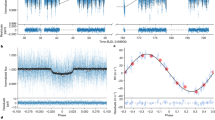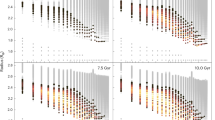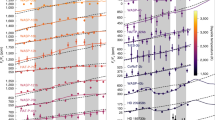Abstract
THE physical conditions in the planetary nebulæ are such that atoms or ions in metastable states are not disturbed by electron impact or the absorption of radiation during their lifetimes of one minute or more. The intensity of a forbidden emission line (due to transitions from such a metastable state) is then1 I = nhv, where n is the number of ions arriving in the metastable state per second, and hv is the energy emitted from each transition. It is possible to determine the relative abundance of ions in the nebulae from the observed2 intensities of their forbidden lines (listed in cols. 5 and 7 of the Table), if, following Bowen, we assume the excitation to the metastable state to be due solely to inelastic electron collisions, that is, n is proportional to N(w)p(v,w)(E), where N{w) is the number of ions of atomic weight w per c.c, p(v,w) is the probability of electron collision and resultant excitation, and (E) is the number of electrons per c.c. with kinetic energy greater than the excitation potential, E, of the ion.
This is a preview of subscription content, access via your institution
Access options
Subscribe to this journal
Receive 51 print issues and online access
$199.00 per year
only $3.90 per issue
Buy this article
- Purchase on Springer Link
- Instant access to full article PDF
Prices may be subject to local taxes which are calculated during checkout
Similar content being viewed by others
References
I. S. Bowen, Rev. Mod. Phys., 8, 69 (1936).
T. L. Page, Mon. Not. Roy. Ant. Soc., 96, 622 (1936).
cf. Eddington, ” Internal Constitution of the Stars”, p. 383 (Cambridge, 1926).
Lick. Obs. Bull., 15, 97 (1930).
Russell and Menzel, Proc. Nat. Acad. Sci., 19, 997 (1933).
Author information
Authors and Affiliations
Rights and permissions
About this article
Cite this article
PAGE, T. Chemical Composition of the Planetary Nebulæ. Nature 138, 503–504 (1936). https://doi.org/10.1038/138503a0
Issue Date:
DOI: https://doi.org/10.1038/138503a0
Comments
By submitting a comment you agree to abide by our Terms and Community Guidelines. If you find something abusive or that does not comply with our terms or guidelines please flag it as inappropriate.



